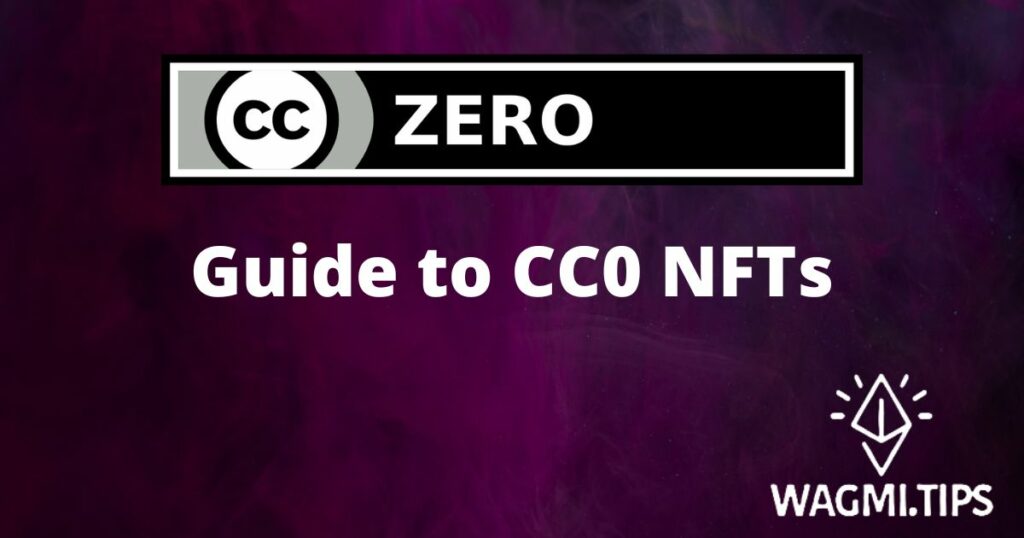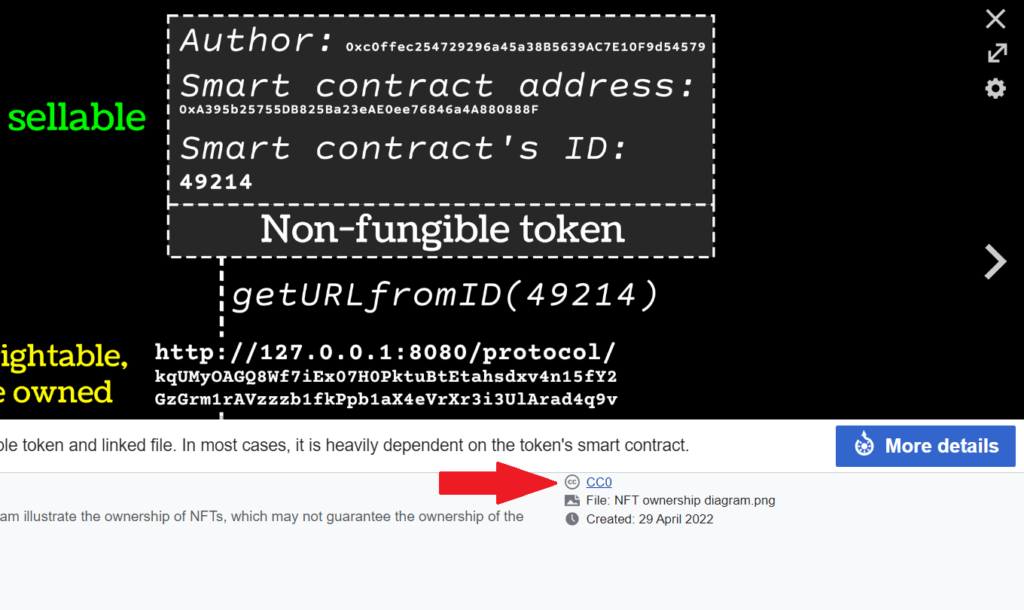The Complete Guide to CC0 NFTs – Best CC0 NFT Projects (2023)
A CC0 (Creative Commons Zero) NFT is a type of NFT with a form of copyright where the owner allows the NFT to be used by anyone for commercial purposes. Our article goes into more detail about intellectual property laws, the creative commons license, and what CC0 NFTs can do.

Table of Contents
What is a CC0 NFT?
To understand what CC0 NFTs are, we first need to understand a little bit about intellectual property laws, licences to use copyright material, and copyrights on NFTs.
Brief Overview of Intellectual Property Law
We know that when a creator publishes a work of art, they own the copyrights to that piece of work, which is considered a form of intellectual property. The protections over this material differs greatly from country to country, depending on local intellectual property (IP) laws.
In the United States, a trademark may be registered on an IP which protects it from being used by others for similar services or goods without permission. Copyright differs from trademarks as it does not require registration with the United States Patent and Trademark Office (USPTO), rather, it exists when the work is created. If it is created by an individual, like an author of a book, the copyright lasts from its creation up to 70 years after the death of the author. After which, the work goes into the public domain where it is no longer protected under copyright law.
Some popular works that are in the public domain include Dracula and the popular classical piece, Fur Elise by Mozart. If someone were to play Fur Elise at a concert, they do not need to gain permission to do so and simply have to attribute the piece to Mozart as the composer.
Licences to Use Copyright Material
Now, let’s look at what this means for people who want to use copyrighted material. The person or group who owns the rights to an IP has control over how this work may be used. If they want others to be able to use it, they will have to decide what licensing rights they want over their work.
For example, if we look at images on Wikipedia from the NFT entry, we see that the illustrator of the following image has decided to put CC0 licensing rights to the image.

As defined by Creative Commons, CC0 essentially means no copyright. Here’s the following explanation for the usages that are permitted for works under the CC0 license:
“The person who associated a work with this deed has dedicated the work to the public domain by waiving all of his or her rights to the work worldwide under copyright law, including all related and neighboring rights, to the extent allowed by law.
You can copy, modify, distribute and perform the work, even for commercial purposes, all without asking permission.”
Yes, the illustrator of that image has put it up for all to use freely and even use it for profit, without needing to contact the illustrator to ask for permission. This is one form of copyright licensing – there are others too, such as CC BY 2.0 which allows other users of the image to freely share or edit the image but have to credit its owner by writing their name or linking to their website in a caption somewhere.
NFTs and Copyrights
So we’ve established what copyrights are. How does it pertain to NFTs?
Unless expressly stated, an NFT holder does not normally hold all rights to their NFT. They may own the NFT, but they may not be allowed to adapt (ie. edit) the NFT or sue someone else for infringing copyrights held on the NFT, such as by adapting it into another image or publishing it as their own. One example of non-CC0 NFTs includes Bored Ape Yacht Club as we have seen some copyright disputes with its derivative NFT projects.
Of course, there are some cases where an NFT project grants its holders limited copyrights to their NFT, such as Cryptokitties. Owners of Cryptokitties have been granted the right to profit up to USD$100,000 annually in revenues from their NFTs. On the other hand, some NFT creators restrict all commercial rights to their work, where its holders are not allowed to, say, profit from printing merchandise of the NFT they own. This article goes into further detail about the copyrights of NFTs and what rights you possess over your NFTs as a holder.
What Can CC0 NFTs Do?
So, all that being said, what can CC0 NFTs do for us? What does it really mean for NFT buyers and what they can do with their NFTs?
A CC0 NFT project, such as CrypToadz and Nouns, allows the NFTs to be used for commercial purposes without attributing to the original creator. This solves the problem of copyright issues in the NFT world. Creators are able to freely grant others permission to use their work in whatever way they want. This allows the community behind the NFTs to adapt the NFTs into other forms of content, which adds value to the project. As the blockchain will have a permanent record of the NFT’s creator and owner, it’s arguable that CC0 NFTs have changed how we think of IP and copyrights to digital assets.
Popular CC0 NFT Projects
CrypToadz
The CrypToadz project is a collection of 6969 toad-like creatures. In the CrypToadz world, these unique creatures are attempting to escape Evil King Gremplin, their tyrannical ruler. The ETH blockchain NFTs are created using the ERC-721 token standard. The sold-out project has its great success attributed to it being a CC0 project. The art on these NFTs is in the public domain with no rights reserved, so its owners and community are free to use them, in accordance with the CC0 license.
CryptoDickButts
CryptoDickButts is another CC0 NFT project with a very unique art style which originally started out as a joke. The developers have kept the project simple. There are no roadmaps or utilities to the project, just the NFT art that’s available to the public under the CC0 license. Sold at 0.052 ETH per NFT, the Series 3 collection which had 5200 NFTs are now (at the time of writing) standing at around 1 ETH at floor price. The success of this project is a great example of the draw of CC0 NFTs to the NFT community.
Goblintown.wtf
Goblintown.wtf is a collection of 10,000 NFTs of unsightly creatures which consist of mostly goblins and include other creatures such as dragons, trolls, wizards, and more that reside in Goblin Town. The project is launched by an anonymous group of developers who are speculated to be associated with Yuga Labs, the creators of Bored Ape Yacht Club. The CC0 project also has no utility, roadmap, or even a Discord for its community. Instead, it had free minting which offers those new to the space a low-cost barrier to owning an NFT. For more information about Goblintown, check out our Goblin Town NFT review.
Mfers
On the surface, Mfers may seem like a meme project – it simply has a page on OpenSea with no elaborate website and a now-defunct mint page. Despite that, the NFTs at the time of writing have a price floor of 1.67 ETH when the collection of 10,000 NFTs originally minted at 0.069 ETH. The project by Sartoshi, an artist known to the NFT community, has no utility or roadmap like many others on our list. Its draw is simply its CC0 artwork and the organic community.
Nouns
One of the first CC0 NFT projects, Nouns was started by a group of NFT collectors and developers who are well-known in the NFT space. What started out as an experimental CC0 project has been one of the most successful and has made at least $100 million in total to date. All ETH proceeds from daily auctions go to NounsDAO, the governing organisation over the project where token holders are able to vote on how resources are spent. Recently, NounsDAO signed a professional DOTA e-sports team and has plans for merchandise such as sunglasses and coffee, with future plans to start a real-world cafe. With a solid team, a thriving community, and a DAO leading its way, the Nouniverse is definitely one to watch.
Rektguy
The story behind Rektguy is one that’s all too familiar to the NFT world – it’s an NFT/crypto broker who has been rekt by the recent price crash. NFT backer, Ovie Faruq or OSF, is the person behind the project, along with Alien Queen. OSF is a prominent name in NFT spaces, with nearly 120k followers on Twitter – this has lent itself well to the success of rektguy. Additionally, the project has been supported by Cozomo de’ Medici and Snoop Dogg, who are also famous in these circles.
Tiny Dinos
Tiny Dinos is self-described as an omnichain CC0 NFT project which has “no roadmap, just tiny dinos”. This project of 10,000 simple pixellated dinosaurs had free minting and offered a few interesting perks that are relatively new trends for NFTs. The omnichain NFTs are transferrable between chains – owners simply need to wrap the NFTs for trade on a different chain. Owners can also change the background of the NFTs which allows some level of customisation. The simplicity of the artwork in this project is a prime example of how simple sometimes is better.
Creative Commons Zero NFTs - Conclusion
It seems that for many of these CC0 projects, the freedom for collectors to do anything they want with the artwork makes up for the lack of utility and roadmap. Many prominent NFT projects that are CC0 have managed to top the charts in the NFT marketplaces. This may suggest that it is one of the traits active investors are looking for when NFT shopping. If you’re looking to buy an NFT, you might want to keep an eye out for CC0 NFTs in the future.
